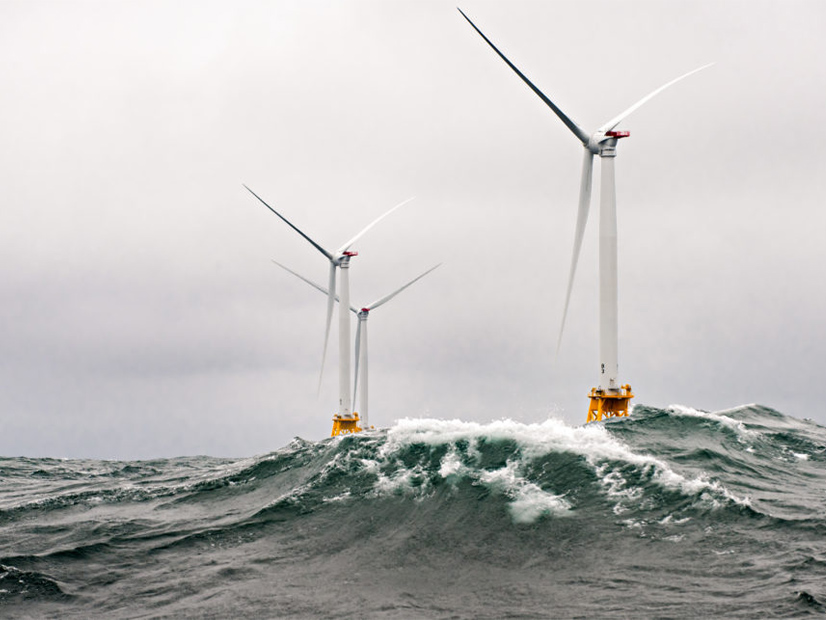To meet its target of 25 GW of offshore wind energy by 2045, California will need about 1,300 floating wind turbines, along with seaport sites to support production and operation of the massive structures, speakers said during a workshop.
Potential locations for those sites were the focus of a workshop on Monday hosted by the California Energy Commission (CEC). The commission is facing a June 30, 2023, deadline to complete a strategic plan for offshore wind, including a blueprint for improving waterfront facilities to support OSW development.
Seaport sites are needed for fabrication and assembly of wind turbine components, a process that requires sheltered harbor space, wide areas, deep, navigable water, and the capacity for heavy loads, said Matt Trowbridge, an engineer with Moffatt & Nichol, a port infrastructure consulting firm.
Other sites may serve as operations and maintenance facilities for the turbines once they’re in place, Trowbridge said during the workshop. These sites will ideally be as close as possible to the wind farms.
California will need an estimated 1,300 floating wind turbines to meet the 2045 target of 25 GW, Trowbridge said, and potentially 10 or more seaport sites to support them. One port might be able to accommodate multiple support sites, he noted.
Currently, California doesn’t have any such sites, he said.
“There is no existing port terminal on the U.S. West Coast that can currently support offshore wind,” Trowbridge said. “There’s space available in the ports, but no facility is adequate for offshore wind without significant investment.”
Searching for Sites
Trowbridge said 17 major ports and harbors have been contacted to see if they’re interested in participating in OSW and, if so, whether they have space to do so. The results of the survey are “promising,” Trowbridge said, but details won’t be released until the ports have a chance to weigh in on the findings.
Small craft harbors are also being explored as potential sites for OSW operations and maintenance.
“We’re trying to turn over every stone,” Trowbridge said. “We’re looking at every possibility to try to identify the pros and cons and the best path forward.”
But Trowbridge emphasized that the search for OSW support sites is not intended to displace existing uses. Rather, the study is looking for undeveloped or underutilized sites.
The discussion of OSW support sites comes as the U.S. Bureau of Ocean Energy Management plans a Dec. 6 auction of five leases off the Northern and Central California coasts. (See BOEM Sets California Offshore Wind Auction Date.) Two leases, with a combined potential for about 1.6 GW of wind energy, are in the Humboldt Wind Energy Area off the coast of Northern California. Three leases in the Morro Bay Wind Energy Area have a combined potential of about 3 GW.
Because the Morro Bay lease area is far from existing ports, the State Lands Commission is studying whether there’s a suitable site for a new port between the San Francisco Bay Area and Long Beach.
So far, that option doesn’t seem viable, although it hasn’t been ruled out, Trowbridge said. Much of the coastline was deemed unsuitable because it’s near a residential area, a military base, a state park or national forest, or a marine sanctuary. And while the study hasn’t been completed, it appears that building a new port in one of the remaining areas would be less feasible than developing a site at an existing port.
The port infrastructure study won’t stop at identifying potential OSW support sites. Additional steps will include looking at improvements needed at the sites and potential impacts.
Head Start at Humboldt
The Humboldt Bay Harbor, Recreation and Conservation District is actively exploring playing a role in the OSW industry, Rob Holmlund, the district’s director of development, said during the workshop.
Humboldt Bay’s Northern California location is between two wind “hot spots,” Holmlund said, and the harbor has the potential to support OSW in both the Morro Bay and Humboldt wind energy areas. The harbor lacks constraints such as limited channel width or depth, or bridges that could block turbine transport, he said.
The Port of Humboldt Bay developed a conceptual master plan for the site, which was followed in March by a $10.45 million CEC grant to prepare the bay for offshore wind. The grant will help pay for preliminary engineering and design work, site surveys and special studies, environmental impact assessments, early construction, and environmental mitigation.
Last week, the port announced it will exclusively negotiate with Crowley Maritime to develop and operate the Humboldt Bay Offshore Wind Heavy Lift Marine Terminal. The terminal will support tenants in the manufacturing, installation and operation of offshore wind floating platforms, as well as the use of large heavy cargo vessels and crewing and marshaling services in the ocean.
The agreement with Crowley involves a 98-acre Phase I, with an option for future phases.
AB 525 Requirements
Port infrastructure development is one piece of a five-part strategic plan for OSW required by last year’s Assembly Bill 525. Other sections of the plan will focus on sea space identification, transmission planning, permitting and potential impacts of OSW.
AB 525 also requires the CEC to determine the state’s maximum feasible capacity for OSW and set planning goals for 2030 and 2045.
In August, CEC adopted the nation’s most ambitious long-term offshore wind goals, with targets of up to 5 GW by 2030 and 25 GW by 2045. (See Calif. Adopts Country’s Most Ambitious OSW Targets.)
CEC will accept comments related to the workshop through Nov. 18 at 5 p.m. Comments may be submitted here.

